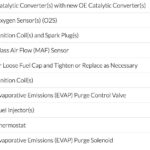OBD and OBD2 are terms frequently encountered in the automotive world, but their meaning and importance often remain unclear. This comprehensive guide delves into the intricacies of On-Board Diagnostics, explaining its function, history, and impact on vehicle maintenance and emissions.
What is OBD OBD2?
OBD, or On-Board Diagnostics, is a standardized system that allows technicians and car owners to access a vehicle’s diagnostic information. OBD2, introduced in 1996, is the second generation of this technology and is now a standard feature in most gasoline vehicles. Obd Obd2 systems monitor various components impacting emissions, identifying malfunctions and storing crucial data for troubleshooting. When an issue is detected, the system illuminates the “Check Engine” or “Service Engine Soon” light, alerting the driver to a potential problem.
The Evolution from OBD to OBD2
Prior to OBD2, the first generation of On-Board Diagnostics (OBD) offered limited diagnostic capabilities. Introduced in 1988 in California, OBD only monitored a small number of emission components without specific performance benchmarks. This limited effectiveness paved the way for the development of OBD2, a more comprehensive and user-friendly system for diagnosing vehicle issues. OBD OBD2 addressed the shortcomings of its predecessor by expanding the range of monitored components and standardizing the diagnostic process.
The Importance of OBD OBD2 for Emissions Control
OBD OBD2 plays a vital role in minimizing vehicle emissions. While new vehicles are designed with stringent emission standards, malfunctions can lead to significant increases in pollutants. OBD OBD2 systems actively monitor emission-related components, ensuring that vehicles remain compliant with environmental regulations throughout their lifespan. Early detection of malfunctions through OBD OBD2 facilitates timely repairs, preventing excessive emissions and contributing to cleaner air.
OBD OBD2 Compatibility and Requirements
All gasoline cars and light trucks sold in the United States since 1996 are required to be OBD2 compliant. This standardization simplifies diagnostics and repairs, allowing technicians to access diagnostic information using a universal connector and standardized codes. While California initially spearheaded the implementation of OBD2, the U.S. Environmental Protection Agency (EPA) adopted similar requirements nationwide, making OBD OBD2 a universal standard.
Troubleshooting with OBD OBD2
When the “Check Engine” light illuminates, it’s crucial to address the underlying issue promptly. While the severity of the problem can vary, ignoring the warning light can lead to further damage and decreased fuel efficiency. OBD OBD2 systems provide valuable diagnostic information, enabling technicians to pinpoint the source of the malfunction and perform targeted repairs. Utilizing an OBD OBD2 scanner allows access to diagnostic trouble codes (DTCs), which provide specific insights into the nature of the problem.
OBD OBD2 and Vehicle Maintenance
OBD OBD2 empowers car owners and technicians with valuable data for proactive maintenance. By monitoring various vehicle systems, OBD OBD2 can identify potential issues before they escalate into major problems. Regularly checking OBD OBD2 data can help prevent costly repairs and ensure optimal vehicle performance.
OBD OBD2 and Smog Checks
In many states, including California, OBD OBD2 plays a central role in smog check inspections. Technicians use OBD OBD2 scanners to assess the vehicle’s emission system and verify its compliance with regulations. A properly functioning OBD OBD2 system is essential for passing a smog check, ensuring that vehicles meet required emission standards. Incomplete readiness indicators, often due to recent repairs or battery disconnections, can result in a failed smog check.
OBD OBD2, Aftermarket Parts, and Vehicle Modifications
The use of aftermarket parts and vehicle modifications does not necessarily conflict with OBD OBD2 compliance. Aftermarket parts manufacturers must ensure their products are functionally equivalent to original equipment and compatible with OBD OBD2 systems. California Air Resources Board (CARB) regulations require exemptions for performance-enhancing parts, ensuring compatibility with OBD OBD2 and preventing negative impacts on emissions.
The Future of On-Board Diagnostics: OBD III
While OBD2 remains the current standard, the concept of OBD III, or remote OBD, is under development. OBD III envisions wireless transmission of diagnostic data, potentially eliminating the need for physical inspections. This technology could streamline emissions monitoring and facilitate proactive vehicle maintenance.
For further information regarding OBD regulations and programs, consult the California Air Resources Board (CARB) website.

